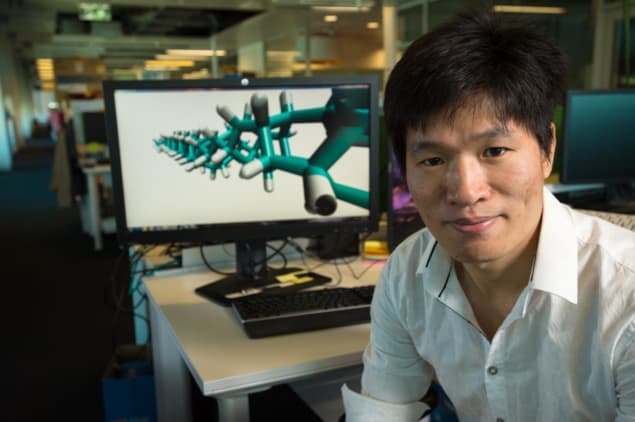
Computational and theoretical studies of diamond-like carbon nanothreads suggest that they could provide an alternative to batteries by storing energy in a strained mechanical system. The team behind the research says that nanothread devices could power electronics and help with the shift towards renewable sources of energy.
The traditional go-to device for energy storage is the electrochemical battery, which predates even the widespread use of electricity. Despite centuries of technological progress and near ubiquitous use, batteries remain prone to the same inefficiencies and hazards as any device based on chemical reactions – sluggish reactions in the cold, the danger of explosion in the heat and the risk of toxic chemical leakages.
Another way of storing energy is to strain a material that then releases energy as it returns to its unstrained state. The strain could be linear like stretching and then launching a rubber band from your finger; or twisted, like a wind-up clock or toy. Over a decade ago, theoretical work done by researchers at the Massachusetts Institute of Technology suggested that strained chords made from carbon nanotubes could achieve impressive energy-storage densities, on account of the material’s unique mechanical properties.
Outperforms carbon nanotubes
Now, a new theoretical study by a team including Haifei Zhan, Gang Zhang and Yuantong Gu at Queensland University of Technology in Australia and the Agency for Science, Technology and Research (A*STAR) in Singapore reveals there may be circumstances in which bundles of carbon nanothreads outperform carbon nanotube bundles in terms of energy storage.
“We expected a good mechanical energy storage capability [for carbon nanothreads],” says Zhang of their results. “But surprisingly we found its energy density can be up to three times the lithium-ion battery in theory.”
First described in 2015, nanothreads joined a catalogue of carbon nanomaterials that have emerged over the past four decades. Nanothreads are 1D structures with carbon atoms linked by single bonds (like those in diamond) to three other carbon atoms and a hydrogen atom. Where the hydrogen atom is missing, the carbon atom may bond to a fourth carbon atom in an adjacent thread. This bonding contrasts with the hexagonal carbon lattices found in buckyballs, carbon nanotubes and graphene. In these materials, electron orbitals from each carbon atom are shared between just three other carbon atoms.
Space elevator
Since 2015 studies have revealed several ways that carbon atoms can arrange themselves in a 1D carbon nanothread structure. Furthermore, several threads can be bundled together to create a chord with mechanical properties that are comparable to carbon nanotube bundles — which are so strong it was once proposed they could tether extraterrestrial objects from Earth to create a “space elevator”.
“The excellent mechanical properties of fibres of carbon nanothreads make them appealing alternative building blocks for energy storage devices, to power advanced microdevices and systems,” explains Zhang.
The team used molecular dynamics simulations and theory to compare the maximum energy stored under tension, torsion and bending for a specific type of carbon nanotube bundle and two nanothread bundle conformations – one straight and one helical.
Armchair nanotubes
Carbon nanotubes come in different widths and chiralities – the angle the carbon sheet is rolled along with respect to the honeycomb lattice. All these variations affect the nanotube’s properties. The team made its comparison using (10,10) “armchair” carbon nanotubes. These nanotubes are rolled perpendicular to the lattice lines giving half hexagon shapes ten carbon atoms long at the end of the tube. These are wide for carbon nanotubes, but they are also among the most commonly synthesized.
The research identified several drawbacks of using carbon nanotubes for energy storage – and several advantages of using carbon nanothreads. One problem with nanotubes is that they are prone to flatten when twisted or bent, which reduces the energy they can store under strain. In contrast, nanothreads retain their atomic conformation under strain. While individual carbon nanotubes have better properties for energy storage than single nanothreads, this advantage is not maintained when nanotubes are bundled. In contrast, bonds that can form between nanothreads where a hydrogen is missing make them better team players, so that a bundle with 19 nanothreads achieves 2.5 times the energy storage density of a bundle with three threads.
Another drawback of carbon nanotubes is that bundles can only sustain about a third of the torsion of a single nanotube, resulting in less favourable energy storage density in comparison with nanothreads.
“Carbon nanothread bundles could be made into twist-spun yarn-based artificial muscles that respond to electrical, chemical or photonic excitations,” suggests Zhang. “They could be a potential micro-scale power supply for anything from implanted biomedical sensing systems monitoring heart and brain functions, to small robotics and electronics.”
In pursuit of experimental validation of their results, the researchers are now working with scientists from Penn State University, where the world’s first Centre for Nanothread Chemistry has been established funded by the US National Science Foundation. The collaborative team itself plans to focus its efforts over the next few years building microscale power supply systems based on the results of their research.
The research is described in Nature Communications.



